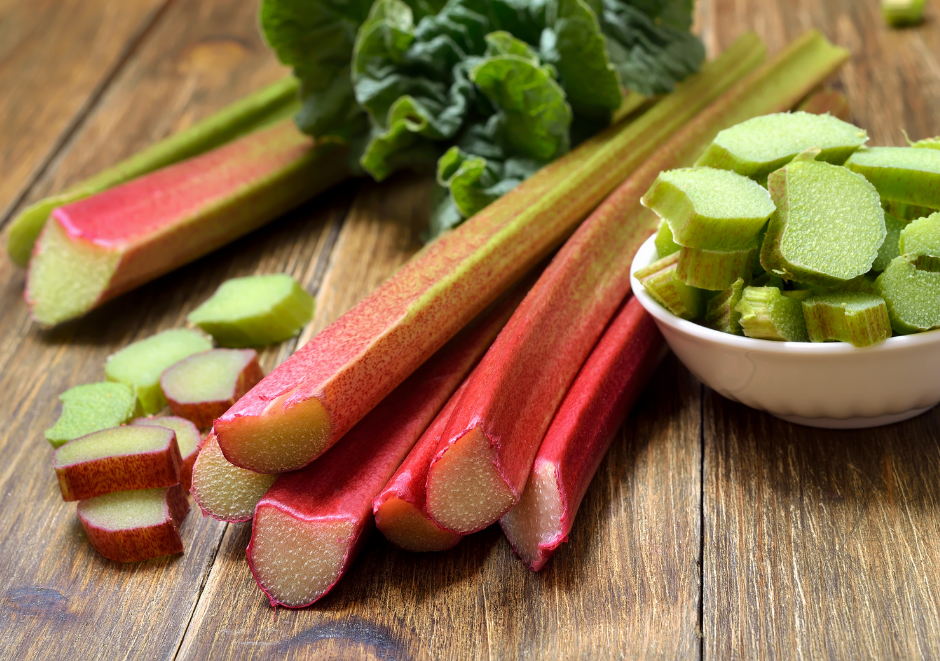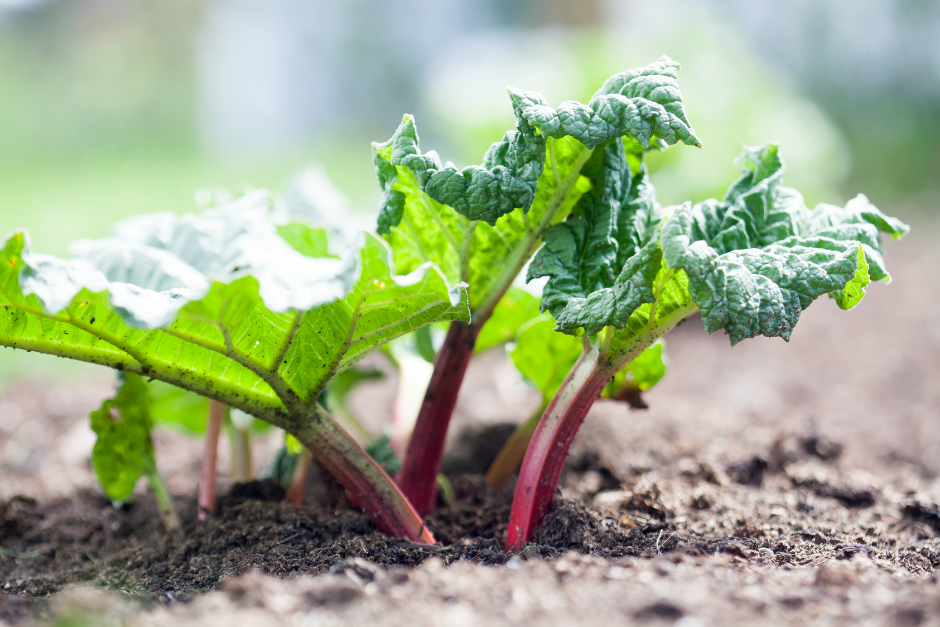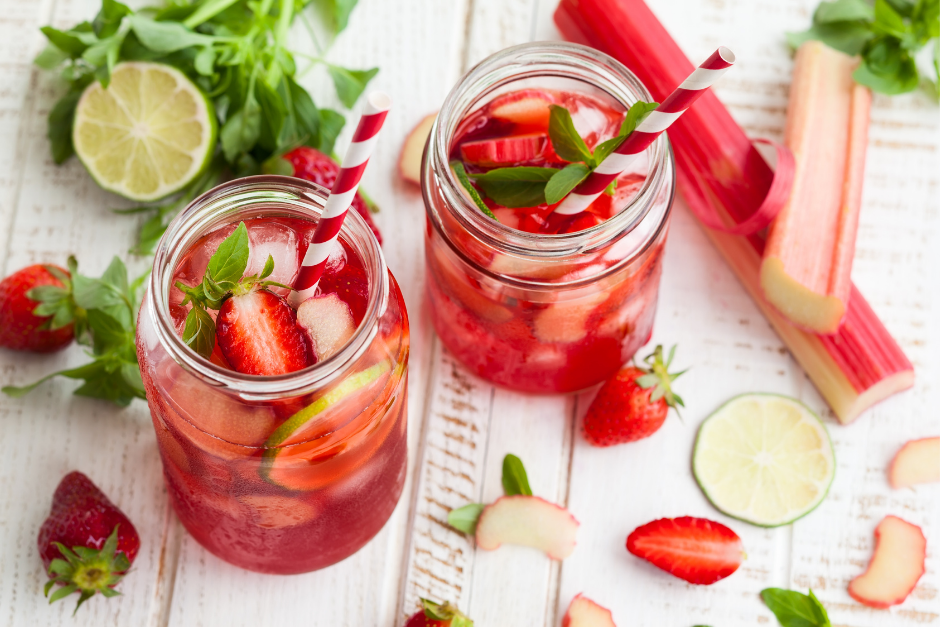Rhubarb is a member of the buckwheat family (Polygonaceae). The stalks are extremely tart with a texture similar to celery. Rhubarb is technically a vegetable, even though it is most commonly prepared like a fruit in sweetened desserts. To some, it is even known by its nickname, ‘pie plant.’

Rhubarb’s popularity grew to a peak just before WWII however, possibly due to sugar rationing, its culinary use dropped dramatically during and after the war. Our grandmother’s strawberry rhubarb jam or pie may forever hold a special place in our hearts, but rhubarb is also beginning to make the spotlight in savory dishes, like salads, pickles, soups, and stews.
Seasonality
Rhubarb is one of the first garden offerings in early May, and is often available until September. Rhubarb is celebrated in Colorado at the Pine Grove Rhubarb Festival (2nd Saturday of June) and Silverton’s International Rhubarb Festival (July 4th). Both festivals feature rhubarb recipe contests and have been a tradition for over 3 decades!
Growing and Harvesting Rhubarb
Rhubarb is a hardy, reliable perennial that requires minimal care and grows very well in Colorado due to our temperate climate.
Most rhubarb varieties should be at least 2 years old before their first harvest. Weather permitting, rhubarb can generally produce 2-3 large harvests each year between May and early July. Rhubarb can also be harvested again in the fall as temperatures begin to cool. The stalks are ready for picking just before the oldest and largest leaves of the stalk start to turn downwards. Stalk length and firmness are the best indication of ripeness. To pick rhubarb, grasp the base of a stalk, pulling it downward and gently twisting to snap the stalk from the ground.

Rhubarb Varieties
There are over 100 known varieties that differ in stalk color, stalk size, sweetness, and productivity. Colors can range from red to green with mixed varieties often called pink or speckled. Color and taste aren’t necessarily related.
Recommended varieties for Colorado include:
- Victoria
- Canada Red
- Turkish
- Colorado Red
- Strawberry
- MacDonald
Selection and Storage
- Choose rhubarb with firm, crisp, glossy stalks. Stalks soften and shrivel as they age and lose moisture. Avoid rhubarb that has hollowed out inside or has blemishes or split ends.
- To store and use fresh rhubarb, remove and discard the leaves, wash the stalks and wrap in a damp towel or plastic bag and place in refrigerator, where it will keep for 1-3 weeks.
Preserving Rhubarb
Freezing: Rhubarb can be frozen for long-term storage as cut pieces or as a cooked mixture. Frozen rhubarb will keep for one year.
- Place in an airtight container and be sure to leave appropriate headspace.
- Label and date the container.
Canning: Rhubarb can be processed in a boiling water bath.
- Use a tested recipe to assure the processing time and method are safe for the elevation at which you live.
Visit the following websites/app for more in-depth rhubarb preservation instructions:
- National Center for Home Food Preservation https://nchfp.uga.edu/
- CSU Extension-Preserve Smart https://apps.chhs.colostate.edu/preservesmart
Nutrition and Health Benefits
Rhubarb is low in calories and rich in nutrients. One cup of diced fresh rhubarb provides:
- 26 calories
- 45% of the daily value of vitamin K
- 12% of the daily value of manganese
- 16% of the daily value of vitamin C
- 10% of the daily value of potassium
Rhubarb also has several types of phytonutrients with health promoting properties:
- The distinctive red color of rhubarb stalks is due to anthocyanin, a type of flavonoid.
- These types of pigments have antioxidant properties and have been shown to be protective against cancer by affecting cell signaling.
- Phytochemicals found in rhubarb have also been reported to help prevent cardiovascular disease.
Rhubarbade (Rhubarb “lemonade”)

Ingredients:
- Rhubarb
- Sugar
- Water
- Puree rhubarb stalks in a food processor, juicer, or blender. Strain juice through cheesecloth, pressing solids. Let the juice stand for several minutes, then skim froth from surface and strain again.
- For every 2 cups of rhubarb ‘juice,’ add ¾- 1 cup sugar and 6 cups of water to yield approximately 8 cups of rhubarbade. Stir until sugar dissolves.
- Serve with ice. Garnish with strawberries, mint and lime slices (optional).
Did you know…
History
- The word ‘rhubarb’ is derived from its Latin genus name, rhabarbarum, so named because it was imported by ancient Romans from unknown barbarians across the Rha River, now known as the Volga River waterway of western Russia.
Food Safety
Only the stalks of the rhubarb plant should be eaten. The leaves are toxic due to a high oxalic acid content.
- High doses of oxalic acid can cause stomach irritation, kidney problems, and calcium dysregulation.
- Persons susceptible to kidney stones are advised to avoid eating rhubarb, as the stalks can contain small amounts of oxalic acid.


